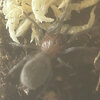- Joined
- Mar 2, 2009
- Messages
- 222
I picked up this Bumba horrida at an expo last week on a whim so looking for some input. I estimate it to be about 1 inch. As soon as I got it in its amac box with a hide it borrowed and covered the opening with dirt. I thought the Breeder said it recently molted when I bought it. I am guessing it could just be getting settled and trying to feel secure in its new enclosure. Anyone with experience with this species have the same thing happen to them? If so, what should I expect next? I know to never dig up a T and it will come out when it’s ready. Basically looking for any feedback on people’s with similar experiences.
Attachments
-
421.3 KB Views: 32


